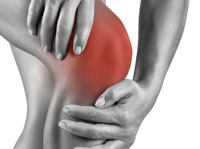 Forty-four-year-old Ms M presented to her GP with pain and swelling of her right knee. She had experienced similar symptoms three years earlier whilst pregnant but had not undergone any investigations at the time. The GP made a provisional clinical diagnosis of recurrent meniscal injury and referred Ms M for an MRI scan.
Forty-four-year-old Ms M presented to her GP with pain and swelling of her right knee. She had experienced similar symptoms three years earlier whilst pregnant but had not undergone any investigations at the time. The GP made a provisional clinical diagnosis of recurrent meniscal injury and referred Ms M for an MRI scan.
The radiologist, Dr A, reported the scan as normal. Plain films taken at the same time showed evidence of mild degenerative change and several small loose bodies above and below the joint, which were not considered significant. Ms M underwent a course of physiotherapy.
Fourteen months later she re-presented with acute locking of the knee after an aerobics class. She was experiencing difficulty sleeping and reduced movement in the knee joint and was referred to Mr B, who noted tenderness over the medial side of the joint and a 15 degree fixed flexion deformity. He advised an arthroscopy for further evaluation. This confirmed the presence of multiple loose bodies and attached soft tissue structures. Mr B made a provisional diagnosis of a foreign body reaction and took biopsies for histology.
Interpretation of the histology proved extremely challenging and the specimens were sent to a number of eminent pathologists for review. The consensus was that this was a high grade, undifferentiated soft tissue sarcoma, although malignant pigmented villonodular synovitis (PVNS) could not be entirely excluded.
A further MRI scan was carried out, which identified a residual soft tissue mass that was also biopsied and confirmed to be consistent with the initial histology. Ms M underwent an above knee amputation followed by chemotherapy.
She subsequently made a claim against Dr A for alleged failure to properly interpret and report on the original MRI scan, thus leading to a delay in diagnosis of synovial sarcoma, which necessitated an above knee amputation.
Expert opinion
In the opinion of the MPS radiology expert, Dr J, Dr A had under-reported the MRI scans in that he had failed to mention the presence of a joint effusion with non-specific tissue in the supra-patellar pouch. In his opinion, however, it would have been inappropriate on this evidence to consider a sarcoma in the differential diagnosis. In the context of a recurrent acute episode these findings were likely to represent breakdown products of blood.
Further investigation would have been dictated by the subsequent clinical course of events, albeit that this may have been influenced by the MRI findings. Mr K, the orthopaedic expert, agreed with Dr J that the MRI findings were non-specific and not indicative of malignancy. Had the MRI been reported in the terms suggested by Dr J, Mr K considered it likely that the GP would have reassured Ms B and treated her conservatively with physiotherapy, which was, in fact, what happened.
Had Ms B’s symptoms not settled down following the first MRI scan it is likely the GP would have referred Ms B to an orthopaedic surgeon who would probably have arranged an arthroscopy, and biopsied the lesion. This would have resulted in the same course of action and outcome as that which subsequently transpired. The treatment options that would have been offered would have been above knee amputation or tumour resection followed by radiotherapy. The prospects of success for the latter option would have been low, with a high risk of recurrence.
In Mr K’s opinion, the only safe option was above knee amputation. He disagreed with the claimant’s expert, Mr C, that amputation would have been avoided had the diagnosis been made 14 months earlier.
MPS argued that although there was a breach of duty by Dr A in failing to report the presence of an effusion and soft tissue within the knee joint, this would not have altered the outcome. Had Dr A reported the MRI scan correctly, management would have been dictated by the subsequent clinical course and would most likely have been conservative in the first instance. From the outset, above knee amputation would have remained the only curative treatment option, and hence the amputation could not be attributed to any failure on Dr A’s part to report the abnormalities on the original MRI scan and so causation could not be established.
Although the claimant could not be persuaded to discontinue on the causation defence alone, it enabled MPS to settle the case for a reduced amount, based on the patient’s additional pain and suffering.
Learning points
- A poor outcome does not necessarily mean negligence.
- In radiology, errors of perception or interpretation that lead to a failure to recommend fur ther investigation may constitute a breach of duty, even if the diagnosis cannot be made from the presenting features. The same principle also applies to failure to elicit or correctly interpret clinical signs and symptoms.
- Breach of duty alone is insufficient to establish negligence. The claimant must prove a causal link between the breach and the subsequent injury or harm suffered.